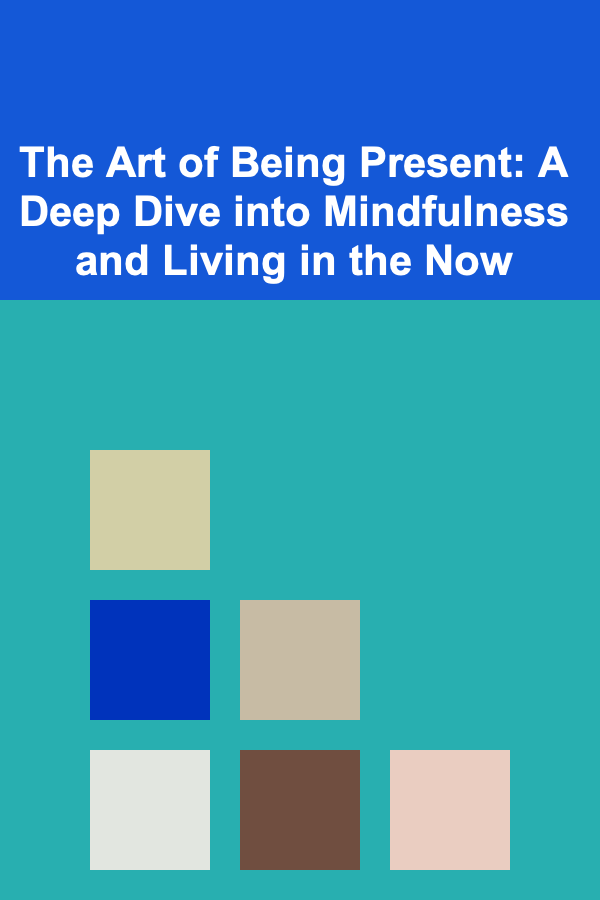
The Art of Being Present: A Deep Dive into Mindfulness and Living in the Now
ebook include PDF & Audio bundle (Micro Guide)
$12.99$10.99
Limited Time Offer! Order within the next:

In a world saturated with distractions, notifications, and the constant hum of technological connectivity, the art of being present has become a precious and increasingly elusive skill. We are perpetually pulled in different directions, our minds often dwelling on past regrets or future anxieties, leaving us disconnected from the richness of the present moment. This article delves into the profound significance of presence, exploring its benefits, the obstacles that hinder it, and practical strategies for cultivating a more mindful and engaged existence.
The Significance of Presence: A Life Fully Lived
The ability to be present is not merely a trendy buzzword; it is a fundamental ingredient for a fulfilling and meaningful life. When we are truly present, we unlock a deeper appreciation for the simple joys that often go unnoticed: the warmth of the sun on our skin, the laughter of a loved one, the beauty of a blooming flower. This heightened awareness allows us to savor experiences more fully, creating lasting memories and a greater sense of contentment.
Beyond personal enjoyment, presence fosters stronger connections with others. By giving our undivided attention to those around us, we communicate genuine interest and empathy. This deepens our relationships, builds trust, and creates a sense of belonging. Imagine the difference between listening to someone while scrolling through your phone versus actively engaging, making eye contact, and truly hearing their words. The latter approach creates a space for vulnerability, understanding, and a more authentic connection.
Moreover, presence enhances our productivity and effectiveness. When we are fully focused on the task at hand, we are less likely to make mistakes, experience distractions, or succumb to procrastination. This allows us to work more efficiently, achieve our goals more effectively, and experience a greater sense of accomplishment. Multitasking, often touted as a sign of productivity, is in reality a presence-killer. It divides our attention, leading to decreased focus and increased stress. Single-tasking with full presence yields significantly better results.
Perhaps most importantly, presence is essential for mental well-being. By anchoring ourselves in the present moment, we can break free from the cycle of negative thoughts and emotions that often plague our minds. Anxiety is often rooted in worries about the future, while depression can stem from dwelling on past regrets. Presence provides a sanctuary from these mental traps, allowing us to experience a sense of calm and inner peace. Mindfulness practices, such as meditation, are designed to cultivate this present-moment awareness and promote emotional regulation.
Obstacles to Presence: The Modern Mind's Dilemma
Despite its numerous benefits, achieving a state of presence can be surprisingly challenging, particularly in today's fast-paced and technologically driven world. We face a constant barrage of stimuli vying for our attention, making it difficult to stay focused and grounded in the present moment. Several key obstacles contribute to this challenge:
- Technological Distractions: Smartphones, tablets, and computers have become ubiquitous, providing us with constant access to information, entertainment, and social connection. However, this constant connectivity can also be incredibly distracting, pulling us away from the present moment and into a virtual world. Notifications, emails, and social media updates constantly interrupt our focus, making it difficult to concentrate on anything for an extended period.
- The Busy Mind: Our minds are often filled with a constant stream of thoughts, worries, and anxieties. These mental chatter can be overwhelming, making it difficult to quiet the mind and focus on the present moment. We may ruminate on past mistakes, worry about future uncertainties, or simply get lost in a web of unrelated thoughts.
- Multitasking: As mentioned earlier, the pressure to be productive often leads us to attempt to multitask, dividing our attention between multiple tasks simultaneously. While this may seem efficient in the short term, it ultimately reduces our ability to focus and be present with any one task.
- Habitual Patterns: Many of us have developed habitual patterns of thinking and behaving that keep us from being present. These patterns may include constantly checking our phones, mindlessly scrolling through social media, or engaging in repetitive thoughts and behaviors.
- Emotional Avoidance: Sometimes, we avoid being present because we fear experiencing difficult emotions. We may distract ourselves with activities or substances to numb our feelings and avoid confronting uncomfortable truths. However, this avoidance ultimately prevents us from healing and growing emotionally.
- societal expectations: Modern society often values productivity and achievement above all else, leaving little room for rest, reflection, and simply being present. The constant pressure to do more, be more, and achieve more can leave us feeling stressed, overwhelmed, and disconnected from ourselves.
Cultivating Presence: Practical Strategies for Mindful Living
Overcoming these obstacles and cultivating a greater sense of presence requires conscious effort and the adoption of specific practices. Here are some practical strategies to help you cultivate the art of being present:
1. Mindfulness Meditation: The Foundation of Presence
Mindfulness meditation is a powerful tool for training your mind to focus on the present moment. It involves paying attention to your thoughts, feelings, and sensations without judgment. This practice helps you become more aware of your mental patterns and develop the ability to observe them without getting caught up in them.
How to Practice:
- Find a quiet space: Choose a place where you can sit comfortably without distractions.
- Sit comfortably: You can sit on a chair with your feet flat on the floor, or on a cushion with your legs crossed. Maintain a straight but relaxed posture.
- Focus on your breath: Bring your attention to the sensation of your breath as it enters and leaves your body. Notice the rise and fall of your chest or the feeling of the air passing through your nostrils.
- Acknowledge your thoughts: As you meditate, your mind will naturally wander. When you notice a thought, simply acknowledge it without judgment and gently redirect your attention back to your breath.
- Start small: Begin with just a few minutes of meditation each day and gradually increase the duration as you become more comfortable. Even five minutes of daily meditation can make a significant difference.
There are numerous guided meditation apps and online resources available to help you get started. Consistency is key to developing a regular meditation practice.
2. Sensory Awareness: Engaging Your Senses
Engaging your senses is a simple yet effective way to anchor yourself in the present moment. By paying attention to what you see, hear, smell, taste, and touch, you can fully immerse yourself in your immediate surroundings.
How to Practice:
- Mindful Observation: Take a few moments each day to observe your surroundings with fresh eyes. Notice the colors, shapes, and textures of objects around you. Listen to the sounds of nature or the rhythm of the city.
- Mindful Eating: When you eat, pay attention to the flavors, textures, and aromas of your food. Chew slowly and savor each bite. Avoid distractions such as television or your phone.
- Mindful Movement: Engage in activities that involve your body, such as walking, yoga, or dancing. Pay attention to the sensations of your body as you move, and focus on the present moment rather than your thoughts.
- The 5-4-3-2-1 Grounding Technique: This technique is particularly helpful when feeling anxious or overwhelmed. Identify 5 things you can see, 4 things you can touch, 3 things you can hear, 2 things you can smell, and 1 thing you can taste. This grounding exercise brings you back to the present moment by focusing on your senses.
3. Digital Detox: Disconnecting to Reconnect
Reducing your exposure to technology is crucial for cultivating presence. Constant connectivity can be incredibly distracting, making it difficult to focus and be present with yourself and others.
How to Practice:
- Set Boundaries: Establish specific times each day when you will disconnect from technology. This may include turning off your phone during meals, limiting your social media usage, or avoiding screens before bed.
- Create Tech-Free Zones: Designate certain areas of your home, such as your bedroom or dining room, as tech-free zones.
- Mindful Phone Usage: Be mindful of how often you check your phone and ask yourself if it is truly necessary. Turn off notifications to reduce distractions.
- Engage in Offline Activities: Replace screen time with activities that you enjoy, such as reading, spending time in nature, or pursuing a hobby.
- The Power of "Do Not Disturb": Utilize the "Do Not Disturb" feature on your phone to block notifications and calls during specific times, allowing you to focus on the present moment without interruption.
4. Single-Tasking: Focusing on One Thing at a Time
Instead of trying to juggle multiple tasks simultaneously, focus on completing one task at a time with your full attention. This will not only increase your productivity but also enhance your ability to be present.
How to Practice:
- Prioritize Your Tasks: Before you begin working, identify the most important tasks that need to be completed.
- Eliminate Distractions: Create a quiet and distraction-free environment where you can focus on your work.
- Break Down Large Tasks: Divide large tasks into smaller, more manageable steps.
- Focus on the Present Moment: As you work, pay attention to the task at hand and avoid getting distracted by thoughts or worries.
- Take Breaks: Take short breaks every hour to stretch, move around, and clear your mind.
5. Gratitude Practice: Appreciating the Present
Cultivating gratitude is a powerful way to shift your focus from what you lack to what you have. By appreciating the simple joys and blessings in your life, you can cultivate a greater sense of contentment and presence.
How to Practice:
- Gratitude Journal: Keep a journal and write down things you are grateful for each day. This could include anything from your health and well-being to your relationships and opportunities.
- Gratitude Meditation: Take a few moments each day to reflect on things you are grateful for. Visualize these things and allow yourself to feel the emotions associated with them.
- Express Gratitude to Others: Take the time to express your gratitude to the people in your life. This could include sending a thank-you note, giving a compliment, or simply telling someone how much you appreciate them.
- Notice the Small Things: Pay attention to the small things in life that you often take for granted, such as the beauty of nature, the taste of good food, or the warmth of a hug.
6. Mindful Communication: Listening with Intention
Being present during conversations is crucial for building strong relationships and fostering genuine connection. It involves actively listening to the other person without interrupting or judging, and truly trying to understand their perspective.
How to Practice:
- Pay Attention: Give the other person your undivided attention. Make eye contact, put away your phone, and avoid interrupting.
- Listen Actively: Focus on understanding what the other person is saying, both verbally and nonverbally. Ask clarifying questions and summarize their points to ensure that you are understanding them correctly.
- Empathize: Try to put yourself in the other person's shoes and understand their perspective. Acknowledge their feelings and validate their experiences.
- Avoid Judging: Refrain from judging the other person or their opinions. Listen with an open mind and try to understand where they are coming from.
- Be Present with Your Own Emotions: Notice any emotions that arise within you during the conversation and acknowledge them without getting carried away by them. This will help you stay grounded and present in the moment.
7. Acceptance: Embracing the Present Moment as It Is
Acceptance is a key component of presence. It involves embracing the present moment as it is, without resistance or judgment. This does not mean that you have to like everything that happens, but it does mean that you accept the reality of the situation.
How to Practice:
- Observe Your Thoughts and Feelings: Notice your thoughts and feelings without judging them. Acknowledge them and let them pass without getting carried away by them.
- Let Go of Resistance: When you find yourself resisting the present moment, try to let go of that resistance. Accept the situation as it is and focus on what you can do to make the best of it.
- Practice Self-Compassion: Be kind and compassionate to yourself, especially during difficult times. Acknowledge your struggles and remind yourself that you are not alone.
- Focus on What You Can Control: Instead of dwelling on things you cannot control, focus on what you can control, such as your thoughts, feelings, and actions.
8. Spending Time in Nature: Reconnecting with the Natural World
Spending time in nature can be incredibly grounding and restorative. The natural world has a calming effect on our minds and bodies, helping us to relax, de-stress, and reconnect with the present moment.
How to Practice:
- Go for a Walk in the Woods: Take a walk in a forest or park and pay attention to the sights, sounds, and smells of nature.
- Sit by a Lake or Ocean: Sit by a body of water and observe the movement of the waves or the ripples on the surface.
- Garden: Spend time gardening and connect with the earth. Feel the soil in your hands and observe the growth of plants.
- Watch the Sunset or Sunrise: Take the time to watch the sunset or sunrise and appreciate the beauty of the natural world.
- Practice Forest Bathing (Shinrin-Yoku): This Japanese practice involves immersing yourself in the forest atmosphere and using your senses to connect with nature.
Conclusion: The Journey to a More Present Life
The art of being present is a lifelong journey, not a destination. It requires consistent effort, patience, and self-compassion. There will be times when you struggle to stay focused and present, and that is perfectly normal. The key is to keep practicing and to be kind to yourself along the way.
By incorporating these strategies into your daily life, you can cultivate a greater sense of presence, enhance your well-being, and experience a more fulfilling and meaningful existence. Embrace the present moment, savor the simple joys, and connect deeply with yourself and others. The journey to a more present life is a journey worth taking.

How Deep Learning Can Help You Build a Passive Income Portfolio
Read More
How to Build a Checklist for Staying Motivated in Your Health Journey
Read More
How to Keep Your Plumbing in Top Shape
Read More
How To Record Interviews with Multiple Cameras
Read More
How to Explore Lending and Borrowing Crypto
Read More
10 Tips for Choosing the Best Health Insurance Plan for Families
Read MoreOther Products

How Deep Learning Can Help You Build a Passive Income Portfolio
Read More
How to Build a Checklist for Staying Motivated in Your Health Journey
Read More
How to Keep Your Plumbing in Top Shape
Read More
How To Record Interviews with Multiple Cameras
Read More
How to Explore Lending and Borrowing Crypto
Read More